A Spring Escape to Lake Kerkini
A springtime haven of wildlife, scenic...
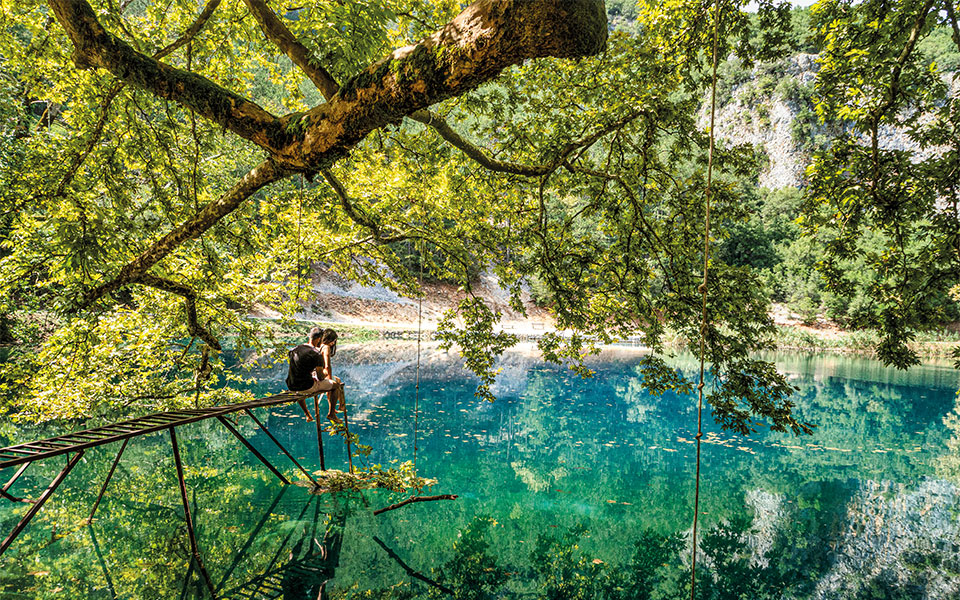
The lake source of the Louros river, approximately halfway between Ioannina and Preveza.
© Perikles Merakos
He climbs the wooden post around 8 o’clock in the morning. He will stay in this position for several hours, observing the movement of the schools in the water. It’s a job that requires patience, concentration, and observation. This is always required of fishermen and is often lonely solitary work. Yet here, a prerequisite for good results is actually teamwork. Michalis, together with Nikos and other members of the Fishing Cooperatives of Preveza, continue to fish using the traditional “daliani” method. On one bank of the Ambracian Gulf, they have spread out a large net on the bottom of the sea. As soon as a school of fish moves above it, they pull the ropes to lift the net and trap the fish. They collect them using two small boats, bringing them to shore and climbing the wooden posts again, waiting for the next one. They catch the most significant numbers in September – when the flathead gray mullets leave the shallow waters of the Gulf and move towards the Ionian Sea to lay their eggs.
The Fishing Cooperative of Preveza has been operating since 1938 and still preserves many traditional fishing methods which respect the area’s precious ecosystem. The cooperative takes advantage of similar movements in the famed divari, which also operates in the Ambracian Gulf and, in essence, is an enclosed lagoon with a controlled entrance and exit. The word “divari” is Slavic and means “wall, dam.” The fish cross the narrow passages still as fingerlings, small in size. When they grow in size, they cannot go to sea again and are trapped. In fact, a sustainable tourism program began this year, where visitors can tour the divari, go fishing, even observe the bottarga production process prepared from the eggs of the female mullet: salted, dried and then dipped in wax for preservation.

The fishing cooperative of Preveza also produces bottarga, otherwise known as "Greek caviar."
© Perikles Merakos

One of the approximately 150 dolphins living in the Ambracian Gulf approaches our excursion boat.
© Perikles Merakos
With its rich plankton, the Ambracian Gulf is a large natural fish farm where we encounter many fish species – from flathead gray mullets and sea bream to sole and sea bass. This is where the famed Ambracian Gulf shrimp also lives and reproduces. There are sustained efforts to have it recognised as a PDO product. If you ask any local whether this shrimp is the most delicious or not, they will no doubt mention the famous line from the 007 movie “For Your Eyes Only,” when James Bond (played by Roger Moore) says: “Shrimp? Yes, but Ambracian.” But this is not all the gulf has to offer.
Pelicans, turtles and more than 150 dolphins live in its waters, while a tour in a traditional “trehandiri” sailboat setting out from Preveza is an unforgettable experience. Giannis Giovanos and his family have been running these excursions for years. As they informed us before departure, dolphins are very social animals and so, when we see them, we should make a lot of noise so they approach us. Sure enough, the dolphins appeared and played right next to our boat’s bow for quite some time!
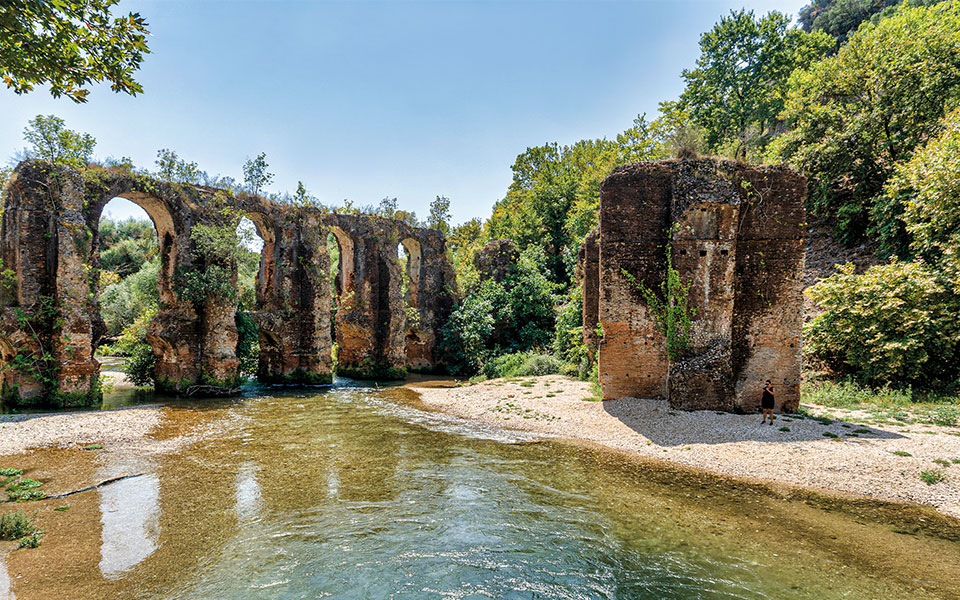
The Roman Aqueduct was 50 kilometers from ancient Nicopolis.
© Perikles Merakos
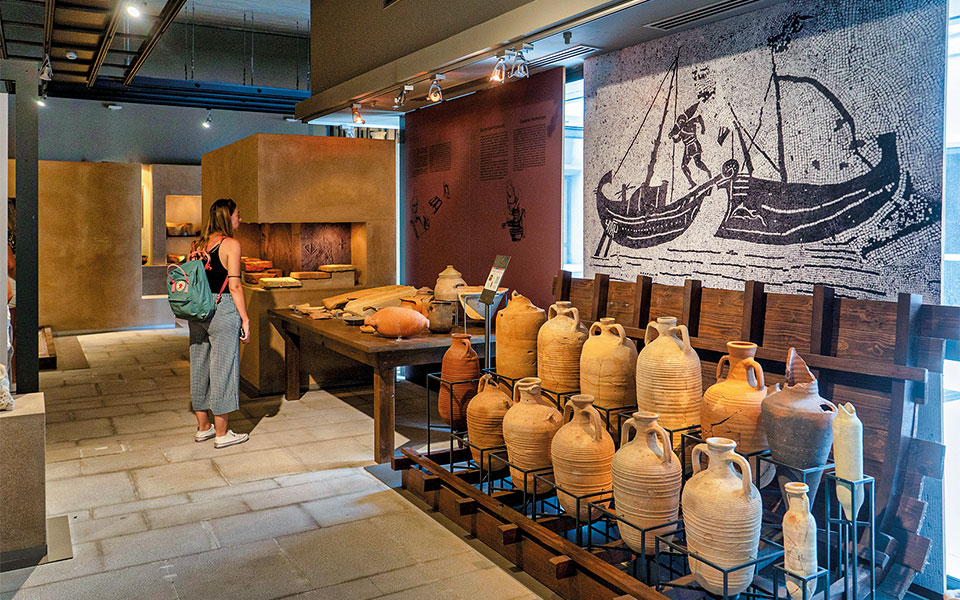
A visit to the Archaeological Museum of Nicopolis.
© Perikles Merakos
Preveza is built exactly on the narrow entrance to the Ambracian Gulf, where it meets the Ionian Sea. The distance between the northernmost point of Akarnania, on the side of Aktio, with the southernmost tip of Preveza, at the port, is just 400 meters. This distance grows a little – to nearly 700 meters – at the location where Greece’s first underwater tunnel was inaugurated in 2002. This tunnel connects Aktio with Preveza and reaches a depth of up to 27 meters below the sea, making it easier to access the city.
Closely associated with fish and seafood, with sardines in particular being the signature dish of the city, the area boasts a rich history that dates back to the naval Battle of Actium in 31 BC. Following his victory over Marc Anthony and Cleopatra, Caesar Augustus decided to build Nicopolis to celebrate his victory, while also serving as a Roman stronghold in Western Greece, in addition to Patras. Nicopolis soon became an important economic and strategic location for the Roman empire. It was later ruled by the Venetians, then the Ottomans, until it was liberated in 1912 and incorporated into the modern Greek state.
The archaeological site of Nicopolis, just outside Preveza, is one of the largest in Greece, a testament to this rich history even though it is not as well-kept and easy to navigate as it should be. In contrast, the Archaeological Museum of Nicopolis offers a clear and cohesive account of the city’s ancient history.
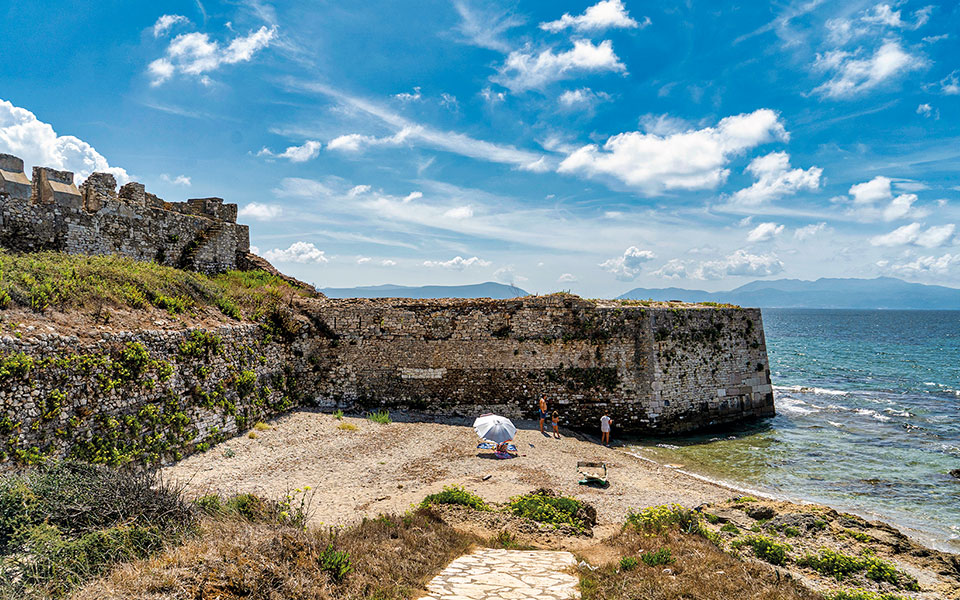
Pantocrator Castle imposes over the Ionian Sea.
© Perikles Merakos

A unique geological phenomenon, the red clay hills at Kokkinopilos.
© Perikles Merakos
Preveza was also later associated with the tragic fate of poet Kostas Karyotakis, who arrived here in 1928 to work in the Prefecture in what turned out to be an unfavorable posting. After attempting suicide in the sea, he finally succeeded in taking his own life by shooting himself in the Margaronas district. This unfortunate event, and the poem entitled “Preveza,” unfairly damaged the area’s reputation.
However, in recent years the promotion of the natural environment surrounding the city, the development of its maritime heritage, as well as the construction of the underwater tunnel connecting Aktion with the Ionia Odos motorway, have somewhat restored its image as an appealing destination. The narrow streets in the city center, the coastal area by the port, the Blue Coast and the Pantocrator Castle are bursting with people from spring to late autumn. And indeed, Preveza is ideal for an autumn weekend escape with its cool temperatures and fewer visitors.

Kayaking for young and old on the Acheron River, before it flows into the sea.
© Perikles Merakos
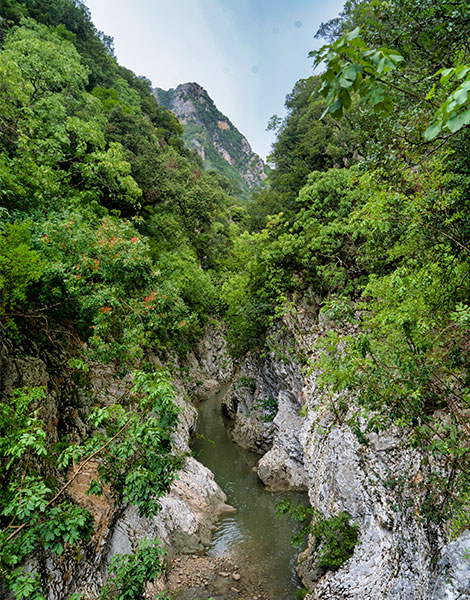
The so-called “Gates of Hades,” a narrow canyon on the Acheron River.
© Perikles Merakos
From the gates of Hades to the estuary lapping the waters of the Ionian at Ammoudia village, the Acheron River is ideal for all kinds of entertaining outdoor activities. The waters flowing along its 52-kilometer course provide irrigation for huge expanses of fields, while also being a site of exceptional natural beauty. The gates of Hades, near the village of Serziana, is actually a euphemism to denote the part of the river where the gorge dramatically narrows.
Further along near Gliki village, the name Springs of Acheron is also a euphemism, as the river’s initial source is located further north, in the Prefecture of Ioannina. The Necromanteion is located further down, which people would visit to make contact with the souls of the dead. In antiquity, the Acheron was referred to as the river of sorrow, being the pre-chamber of the Underworld. According to the myth, Hermes would accompany the souls of the dead to the river crossing to deliver them to Charon, the ferryman. From there they would cross over to the kingdom of Hades. The final section of the river, before the estuary, is the calmest. Here you can go kayaking and enjoy some spectacular birdwatching in the surrounding trees, and, if you’re lucky, encounter coypu (nutria), turtles and other aquatic species.

Playing on the banks of the Ziros Lake.
© Perikles Merakos
Leaving behind the modern highways that connect Preveza with Ioannina, Amfilochia and Southern Greece, it is worth organizing an excursion around the Prefecture, starting at Ziros Lake and moving along the old Arta-Ioannina highway. Ziros lake is located 39 kilometers from Preveza, is surrounded by trees and has a maximum depth of 70 meters. It is ideal for canoeing or kayaking, especially with children, as its waters are always calm and safe.
On the eastern bank, Loukas Zapsas follows all safety measures and respects the natural environment, offering the experience of exploring the lake on a kayak, canoe or SUP. Named “Into the Wild,” this friendly space next to the water features a wooden structure under the shade of the trees. This is where you can take the necessary lessons and instructions before entering the water. There is no limitation regarding time as you can participate in your activity of choice for as long as you wish.
The recommended route is 115 kilometers in length and will take about 2 hours to complete, without any stops.
Into the Wild, tel. (+30) 690.618.0875, intothewild.gr, open until end of October, from €10 per person.

The water mill in Aghios Georgios village is visited by residents from Arta, to wash their carpets and blankets.
© Perikles Merakos
A bit further down, on the old Arta-Ioannina highway, you will have the opportunity to witness a unique geological phenomenon, a complex of red hills known as Kokkinopilos (red clay). The footpath for the hills begins on the national road and you will have to keep a careful lookout, as the sign is very small and not particularly visible (it is located approximately two kilometers after the Louros Hydroelectric Station on your left headed towards Ioannina, before the turn to the village Agios Georgios).
The landscape is reminiscent of images from Mars, as the hills are blanketed in red clay. After the village of Aghios Georgios you will see a sign for the Roman Aqueduct of Nicopolis. Indeed, as unbelievable as it may sound, the aqueduct of ancient Nicopolis was located some 50 kilometers away from the city and took advantage of the difference in height between the city and the Louros River. Arches, tunnels and bridges were constructed to carry the water to Nicopolis.
About 500 meters after the Aqueduct, just outside Aghios Georgios, a traditional water mill that takes advantage of the Louros River is still in operation, where locals come to wash their rugs, carpets, blankets and woollen carpets. A cafe with transparent flooring is also located here, where you will see the waters rushing over the washing tubs. The road to Ioannina continues running in parallel to the Louros River and there are two stops worth taking: at the taverna “Dipla sto Potami” (Hani Terovou, Tel. (+30) 694.671.1897) that serves well-grilled meats, and at the lake sources of the Louros River. Make sure you get on the swings hanging from the trees – an opportunity to feel like a child again, at least for a moment.
TRANSPORTATION
Preveza is located 350 kilometers from Athens, and you will need about 4 hours to get there. Plan to spend 55 euros on fuel and 35 euros on tolls (one way). From Thessaloniki, the distance is also 350 kilometers and you will need 9,85 euros for tolls and 55 for fuel (one way).
ACCOMMODATION
Preveza City Comfort Hotel (61 Irinis, Preveza, Tel. (+30) 26820.895.00, double room with breakfast, from 50 euros). Recently renovated rooms with simple and modern decor. With all modern comforts, from daily cleaning services and flat screen TVs, to fluffy mattresses and a balcony. The superior suit can host up to four people and features two bathrooms.
Dioni Boutique Hotel (4 Kalou, Preveza, Tel. (+30) 26820.273.81, double room with breakfast, from 70 euros). The ideal location for hanging out downtown, near the port, cafes and restaurants, but without the noise. With comfortable and spacious rooms, breakfast is served on the top floor which boasts views over the city and the sea, while there is also a swimming pool if you fancy a quick dip.
Daluz Boutique Hotel (2 Doridos, Psathaki, Preveza, Tel. (+30) 26820.892.20, double room with breakfast, from 110 euros). Ideal for those who appreciate tranquility and isolation, the hotel occupies a large expanse in the Psathaki area, just opposite Preveza. Modern decor, large windows for the light and lovely communal spaces with fresh grassy lawns, a swimming pool and restaurant, where you can enjoy your lovely breakfast each morning.
Meraviglia Slow Living (Mytikas, Preveza, Τel. (+30) 26824.401.20, suite for two, from 290 euros). At a distance of 6 kilometers from the center of Preveza, near Kalamitsi beach, the hotel is built right on the sea. Featuring seven unique suites, each one boasts its own swimming pool and garden.
Alonaki Resort (Alonaki, Pantocratoras, Preveza, Τel. (+30) 26820.255.58, double room with breakfast, from 105 euros). The comfortable and bright rooms are located just a few meters from the beach. The resort also features rooms with private swimming pools and a pool bar.
FOOD
Alati (31 Eleftheriou Venizelou, Τel. (+30) 26820.271.45). High quality seafood and incomparable service at an advantageous spot in the center of Preveza, right on the sea. In addition to fresh fish, the menu also includes grilled octopus served with fava puree from Schinoussa and caramelized onions, as well as orzo risotto with Ambracian shrimp and Moscato Limnou. Extensive wine list, mostly from Greece.
Treli Garida (7 Adrianoupoleos, Τel. (+30) 26820.256.91). For the last 30 years it has been associated with fresh fish and seafood. In the city center, it serves a limited menu with sardines, anchovies, red mullets, mussels, calamari and of course, shrimp. Opt for them served plain and cooked on the grill so you can appreciate their natural flavor. This would be a good place to try the local “petali,” flathead gray mullet filleted in half and then cooked on the grill.
Mezen (16 Dardanellion, Τel. (+30) 26823.069.17). Hearty salads, meze and small dishes ideal for ouzo or tsipouro. Regarding the mains, the seafood orzo with bottarga flakes and citrus zest and the grilled cuttlefish with grilled vegetables stand out.
Tzitzikas (Psathaki, Τel. (+30) 26820.250.80). Hasan is from Turkey and cooks food from his homeland in Preveza. This alone is reason to leave the seafood aside for a bit and indulge in some giaourtlou, lahmatzoun, hunkar and other eastern delicacies.
Chubbies (73 Tsaldari, Τel. (+30) 26820.222.06). Chef Thodoris Mitsis prepares delicious sandwiches at the small place he opened almost two years ago, leaving the grand kitchens of Athens behind. The bread is specially ordered from a local bakery, the cold cuts are prepared in-house, as well as all the sauces and accompaniments. Make your own combinations in one of the three sizes on offer. Do not miss out on the handmade desserts, especially the one with custard and pumpkin.
Barrio (33 Ethnikis Antistaseos & Karyotaki, Τel. (+30) 26820.217.77). Many options for breakfast, brunch, sandwiches, burgers, and salads on offer at Barrio, as well as great coffee.
Ambassador (14 Karyotaki, Preveza, Τel. (+30) 26820.890.88). Come here for the great meat in special cuts, and the lovely patio area. The burger is also very tasty, while the wine list offers some interesting selections.
COFFEE – DRINK
Botilia sto Pelago (9 Theofanous & Ionias, Τel. (+30) 26824.004.32). A large, quiet garden with carefully curated music and a large variety of beers – Czech, Belgian, German, Austrian, Dutch and Greek. You will also find wine, cocktails, coffee and beverages on the menu, as the art cafe “Botilia sto Pelago” is open from the early morning to late at night.
Menta (1 Ethniki Antistasis, Τel. (+30) 26820.295.10). Cafe-meze taverna located in the heart of the city center, a meeting point from the morning to the late evening. Indulge in great coffee. meze and desserts in the spacious square.
ΗΒ (Adrianoupoleos & Niklampa, Τel. (+30) 26820.604.05). The reputation of this tiny place nestled in a narrow street of the city attracts many visitors vying for a place at one of its few tables. It serves just four desserts – ravani (sweet semolina cake), karydopita (Greek walnut cake), apple pie and chocolate pie, each served with soft serve ice cream produced in-house.
Praline (77 Tsaldari, Τel. (+30) 26821.810.22). You will usually see crowds of people, both inside and out, as this pastry shop prepares a variety of delicious fresh desserts every day, ranging from creamy desserts and cakes to profiteroles and ice cream.